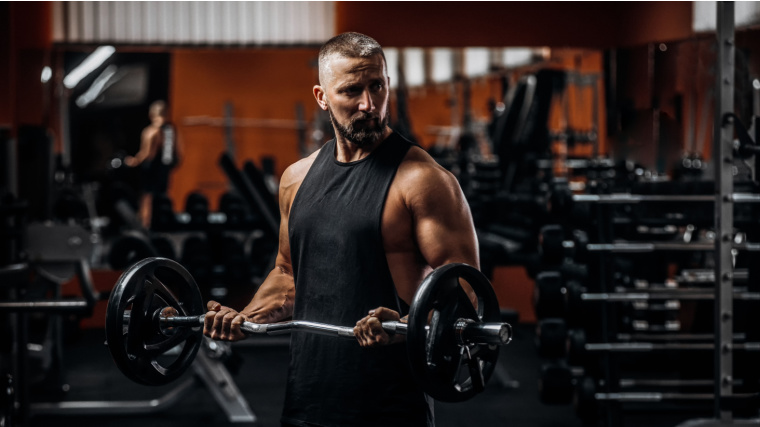Strength starts with weakness. Everyone who commits to getting stronger does so for a reason — they want to improve their health, improve stability as an older adult, need additional strength for their job … the list goes on. Or, maybe you simply want to be strong for its own sake.
No matter your “why,” your next question is probably “how.” And that’s where things start to get a little bit complicated. Strength training has a lot more to it than you might think.

There are more than a handful of different types of strength training, even if they all lead to the same place. So, once you know your destination, you need to decide how you’re going to get there. These are the different types of strength training.
What Is Strength?
Strength has more than one meaning. Colloquially, you hear strength and think of capability; having the means, resources, and/or willpower to carry out a task or perform an action of some kind. And that certainly applies to exercise.
But, more specifically, strength in the context of fitness typically denotes the maximal amount of force you can apply in one “bout” of a given activity. This includes, but isn’t limited to, the well-known “1-rep-max” (1RM) test.
Strength, Power, and Endurance
These three qualities encompass most dimensions of athletic performance. Most of what you do in the gym involves one or more of them at any given time; there aren’t many strength-based exercises that don’t contain some level of power or endurance.
Think of, for example, a 10-rep-max set of back squats. Sure, you’re testing how much weight you can lift for a prescribed number of reps. But you also need the durability to hit all 10 reps in the first place.

[Read More: 7 Barbell Back Exercises That Are NOT the Deadlift]
While strength refers purely to the expression of force, power considers how quickly you can generate that force. If you’ve ever seen an Olympic lifter perform a snatch or clean, you’ve seen this in action — those exercises challenge the amount of weight you can lift as well as how quickly you can lift that weight in the first place.
Types of Strength Training
When it comes to specific types of strength training, there are two primary categories: resistance training and, well, everything else.
Resistance Training
A vast majority of the time when people say “strength training” they mean resistance training — working with free weights like barbells or dumbbells, using a cable machine, exercise machine, and so on.
Any exercise you perform that involves applying external weight to your body counts as resistance training. How you program and perform your exercises in service of a specific goal is what determines if you’re strength training.
The Strength Sports
While recreational resistance training has taken hold as one of the leading forms of exercise, you can certainly make a hobby (or a career) out of it if you choose. There are several formalized strength sports that systematize resistance training. These sporting events are held locally all the way up to the Olympic Games.
- Powerlifting: Tests 1RM strength in the barbell back squat, bench press, and deadlift.
- Weightlifting: Tests 1RM strength and power in the snatch and clean & jerk. Contested at the Olympic Games.
- Strongman: Tests all-around bodily strength through a variety of exercises such as deadlifts, loaded carries, and overhead press variations.
Other sports exist in the realm of these three sports, but aren’t as tightly focused on muscular strength alone. CrossFit includes plenty of maximal strength and strength-endurance tests, and everything from 3 to 10-rep maxes are commonplace in CrossFit workouts and competitions.
Bodybuilders are not judged on any aspect of athletic performance in competition. They are evaluated solely on aesthetics. However, all bodybuilders develop their physiques through resistance training, and so-called “powerbuilding”, which blends in strength-specific training, is quite popular.
Everything Else
Can you train for the purpose of gaining strength without relying on barbells, dumbbells, or kettlebells? Absolutely. Remember, strength is both relative and contextual. If you’re new to physical fitness and can’t yet do your first push-up, working towards it means improving your upper body strength.

[Read More: A One Month Push-Up Training Program for Beginners (3 Days Per Week)]
Bodyweight training counts as strength training up to a point, as you have to strengthen both your muscles and joints to develop robust stability. However, most people won’t get much long-term use out of calisthenics if their goal is to get stronger. Once you can perform several pull-ups at a time, your only options for progression are:
- Move on to more difficult variations
- Increase the number of repetitions you perform
- Add external resistance of some kind
This idea applies to other forms of exercise such as yoga, martial arts, or even rucking. They have a prerequisite level of strength, but partaking in these modalities won’t build strength primarily.
What Is Progressive Overload?
Merely performing resistance training exercises won’t automatically build strength, in the same way that a pot of water set on your stovetop won’t boil unless you turn on the burner. Bodily strength is an adaptation to a demand — your body won’t adapt unless you “force” it to.
The mechanism that forces you to adapt to a stimulus is called progressive overload. The idea here is simple; if gaining strength makes a difficult task easier over time, it follows that you need to expose yourself to more difficult tasks to continue building strength.
[Read More: Best Pre-Workouts]
When it comes to resistance training, progressive overload typically takes the form of gradually increasing the amount of weight you lift, or the reps you perform per set, or the number of sets you perform per workout. For example, say you perform the barbell deadlift once per week:
- Week 1: 5 x 5 with 135 pounds.
- Week 2: 5 x 5 with 140 pounds.
- Week 3: 5 x 5 with 145 pounds.
- Week 4: 5 x 5 with 150 pounds.
This type of slow, incremental progression is the bedrock of progressive overload. Now, make no mistake, you can’t add another five pounds to your barbell indefinitely until the cows come home.
There are diminishing returns and other factors at play that influence the art (and science) of periodization — the general organization of your training to facilitate sustainable progress and avoid plateaus.
[Read More: Best Adjustable Dumbbells]
Scientific research tells us that strength programs which adhere to some form of planned structure like this are far more successful at creating strength gains than if you just went to the gym and winged it every time. (1)
Benefits of Strength Training
Strength training is good for a whole lot more than “just” getting you strong. And the best part is, you don’t need to be a world-class powerlifter to reap these benefits.
Supports Stable Joints
Your muscles attach to, configure, and articulate your joints. Think of them as a lever-and-pulley system. Increasing your strength via resistance training reinforces these structures, making strength training a fantastic way to increase your joint integrity.

[Read More: The Snatch-Grip Deadlift Is an Underrated Strength-Building Exercise]
Research shows that strength training, particularly unilateral (or single-limbed) exercises, is a fantastic form of precautionary care for things like osteoarthritis or mitigating fall risks. (2)
Real-World Carryover
Make no mistake, strength is specific to a degree. Just because you can move one thousand pounds on the leg press doesn’t necessarily mean you can squat double your own body weight with perfect form.
However, the general bodily strength you develop through exercise will certainly carry over into your everyday life. If you’re comfortable doing deadlifts with one or two hundred pounds, picking up a full basket of laundry off the floor should be a breeze.
Improves Mental Health
You’ve probably heard avid weight lifters describe the gym as their own form of therapy. Don’t get it twisted; therapy is therapy, but hitting the iron can certainly be therapeutic. Research has continuously demonstrated that exercise helps manage symptoms of depression, control anxiety, and much more. (3) Strength training is good for more than just molding your muscles.
Helps You Build Muscle
As it turns out, strength and size go hand-in-hand — literally. With all other factors kept equal, a larger muscle with more cross-sectional area has better leverage and, thus, can produce more force.
[Read More: The 15 Best Home Gym Machines]
This creates a synergistic effect between muscle size and strength. (4) And it flows both ways. If you dedicate some time to strengthening your body, you can work with heavier weights over time, which create more mechanical tension, which facilitates greater muscle growth long-term. (5)
Makes Exercise Fun
There’s something to be said for exercising for its own sake. The best way to make a new habit stick is to find a way to make it fun. If you are bored to tears on the treadmill or elliptical, you might consider giving strength training a try instead.
[Read More: The Best Online Workout Programs For Coaching, Cardio, Value, and More]
One of the most addicting parts of weight lifting (for some) is the feeling of consistent, incremental progress. By following a pre-written workout program that incorporates progressive overload, you can turn your fitness regimen into a “game”. For the mathematically-minded who enjoy following a spreadsheet, powerlifting in particular can be a lot of fun to dive into.
Your Takeaways
Strength training is exactly what it sounds like; training to develop more bodily strength. As with anything in the world of health & fitness, though, there’s more going on under the hood.
- Strength training almost always refers to resistance training, or working with weights in some form.
- Other types of physical activity such as traditional sports or bodyweight exercise have a baseline requirement of strength, or develop strength as a byproduct, but aren’t exclusively focused on it.
- There are several formalized strength-based sports, which include powerlifting, weightlifting, strongman, as well as strength-adjacent sports like bodybuilding and CrossFit.
- The best way to gain strength is to follow a pre-written plan that incorporates progressive overload through periodization.
- Strength training confers a number of additional benefits to your physical and mental health.
More Training Content
- How Many Sets Per Muscle Group, Per Week, Should You Do?
- How To Lose Belly Fat — A Strength Athlete’s Guide
- Massage Gun Vs. Foam Roller — Which Is Better for Strength Athletes?
References
- Williams, T. D., Tolusso, D. V., Fedewa, M. V., & Esco, M. R. (2017). Comparison of Periodized and Non-Periodized Resistance Training on Maximal Strength: A Meta-Analysis. Sports medicine (Auckland, N.Z.), 47(10), 2083–2100.
- Behm DG, Colado JC, Colado JC. Instability resistance training across the exercise continuum. Sports Health. 2013 Nov;5(6):500-3. doi: 10.1177/1941738113477815. Erratum in: Sports Health. 2015 Mar/Apr;7(2):184. Colado Sanchez, Juan Carlos [corrected to Colado, Juan C]. PMID: 24427423; PMCID: PMC3806173.
- OConnor, Patrick & Herring, Matthew & Adrian, Amanda. (2010). Mental Health Benefits of Strength Training in Adults. American Journal of Lifestyle Medicine. 4. 377-396. 10.1177/1559827610368771.
- Akagi, R., Kanehisa, H., Kawakami, Y., & Fukunaga, T. (2008). Establishing a new index of muscle cross-sectional area and its relationship with isometric muscle strength. Journal of strength and conditioning research, 22(1), 82–87.
- Schoenfeld B. J. (2010). The mechanisms of muscle hypertrophy and their application to resistance training. Journal of strength and conditioning research, 24(10), 2857–2872.
Featured Image: YAKOBCHUK VIACHESLAV / Shutterstock